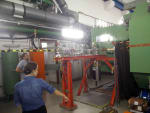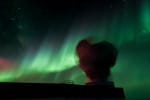Although the sunrise is still not officially here, the South Pole is enjoying a period of twilight. The horizon is clearly visible in the direction of the sun and is showing some characteristic orange color. The photo shows this nicely, with the added effect that reflection in the station windows gives the appearance of a clear view through the windows of the continuous horizon. […]
News
Our summer research experience working on PINGU with researchers at Universität Mainz
The “IRES: U.S.-European International Research Experience-Particle Astrophysics for Undergraduates” program, funded by NSF and led by the University of Wisconsin–River Falls, brought us to Johannes Gutenburg University in Mainz, Germany, this summer to work with Professor Lutz Köpke and Professor Sebastian Böser. […]
Francis Halzen wins 2015 Balzan Prize
Francis Halzen, IceCube principal investigator and Hilldale and Gregory Breit Distinguished Professor at the University of Wisconsin–Madison, was announced yesterday as one of the prestigious international 2015 Balzan prizewinners. […]
Week 34 at the Pole
The South Pole station’s windows were exposed last week, after being covered up (decoratively, we might add) for over four months now. Outside, it still looks more like night than day, but things will gradually brighten up, and then the windows might need to be covered for a different reason—to promote a better sleeping environment. […]
IceCube summer research experience with scientists at Ruhr Universität Bochum
International Research Experiences for Students (IRES) is a program funded by the National Science Foundation to support active participation of US undergraduates in international research projects. Laura Lusardi from New Richmond, WI, and Kelsey Kolell from Fond du Lac, WI, participated in the IRES program through UW–River Falls to work on IceCube research for the summer.
We are both third-year undergraduate students, studying physics at the University of Wisconsin–River Falls. This summer, we had the wonderful opportunity to travel to Germany through IRES to work with IceCube researchers. Even though we both ended up attending the same university, we took wildly different paths to get here. […]
Week 33 at the Pole
The sun is not yet up, but the sky is definitely brightening in its direction. The image below, however, shows that it’s still early twilight and generally quite dark at the Pole. This photo was taken at the same location and time as the one above, just in the opposite direction—quite the contrast. […]
Exploring new directions with DM-Ice and IceCube coincident events
When I came to Yale three years ago, I did not expect to major in physics. Yet, after taking my first class in the subject, it was not long before its fundamental nature and incredible universality had reeled me in for good. Since then, I have sought out opportunities to explore the field and learn what it really means to be a physicist. I joined Assistant Professor Reina Maruyama’s lab this past January and a few months later found myself working on DM-Ice and IceCube. Now, as I gear up for my final year of college, I am spending my summer on campus, conducting research on coincident muon events between the enormous IceCube (1 cubic km) and comparatively miniature (2,309 cubic cm) DM-Ice17 detectors. […]
Week 32 at the Pole
The previous week’s feature image showed the South Pole Telescope with the moon setting behind it. Here we see it again, but set against an aurora backdrop while its dish is scanning the sky for CMB (cosmic microwave background) mapping. […]
IceCube confirms the astrophysical nature of high-energy neutrinos with an independent search in the Northern Hemisphere
Today, the IceCube Collaboration announces a new observation of high-energy neutrinos that originated beyond our solar system. This study, which looked for neutrinos coming from the Northern Hemisphere, confirms their cosmic origin as well as the presence of extragalactic neutrinos and the intensity of the neutrino rate. The first evidence for astrophysical neutrinos was announced by the collaboration in November 2013. The results published now in ”Physical Review Letters” are the first independent confirmation of this discovery. […]
Week 31 at the Pole
It’s still dark at the South Pole, with sunrise not for a while yet. So don’t be confused—that was the moon, not the sun, setting behind the South Pole Telescope. Once it had set, some bright and lively green auroras took over the sky. […]









